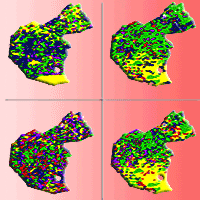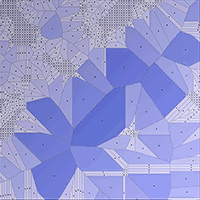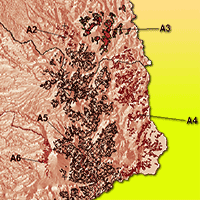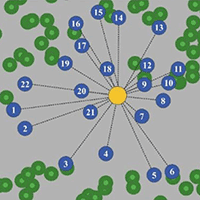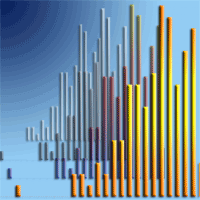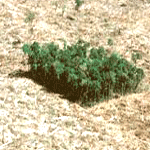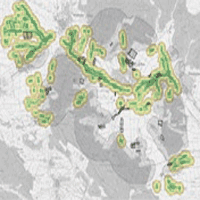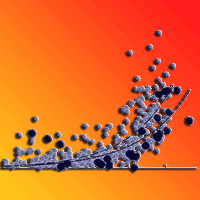Forest management planning requires a permanent collection of data on the distribution, composition, and structure of the stands that conform a woodland. These data serve as the basis for suggesting the most appropriate management scheme according to the natural resource conditions and management objectives. It is common for the collected databases’ structure and dimension to hinder their analysis using traditional descriptive techniques. Therefore, alternative methodologies are required to facilitate both the exploration of data properties and their collective behavior. We used complex networks analysis to identify distribution patterns of topographic, biological, and productive conditions of a managed forest, suggesting its functional zoning. The forest was considered a graph consisting of nodes and edges; the stands served as nodes and interactions between them as edges. Degree, clustering coefficient, triangles, and modularity were used as segregation and connectivity metrics to evaluate forest properties and allocate stands to five predefined potential forest uses (zones). The clustering coefficient metric provided the better graph partition, allowing to obtain the best alternatives for zoning the forest in conservation areas, areas with potential for timber production, and carbon storage. Proposing forest functional zoning through complex network theory is a powerful methodological option to represent the spatial and nonspatial interactions among the relevant attributes defining a forest ecosystem condition.
Keywords
, , ,
Citation
Serrano-Ramírez E, Valdez-Lazalde JR, Mora-Gutiérrez RA, De Los Santos-Posadas HM, Ángeles-Pérez G (2022). Complex networks, an innovative methodology for functional zoning in forest management. iForest 15: 299-306. - doi: 10.3832/ifor3927-015
Academic Editor
Matteo Garbarino
Paper history
Received: Jul 14, 2021
Accepted: Jun 10, 2022
First online: Aug 22, 2022
Publication Date: Aug 31, 2022
Publication Time: 2.43 months
© SISEF - The Italian Society of Silviculture and Forest Ecology 2022
Open Access
This article is distributed under the terms of the Creative Commons Attribution-Non Commercial 4.0 International (https://creativecommons.org/licenses/by-nc/4.0/), which permits unrestricted use, distribution, and reproduction in any medium, provided you give appropriate credit to the original author(s) and the source, provide a link to the Creative Commons license, and indicate if changes were made.

Breakdown by View Type
(Waiting for server response...)
Article Usage
Total Article Views: 27104
(from publication date up to now)
Breakdown by View Type
HTML Page Views: 23597
Abstract Page Views: 1906
PDF Downloads: 1301
Citation/Reference Downloads: 1
XML Downloads: 299
Web Metrics
Days since publication: 1214
Overall contacts: 27104
Avg. contacts per week: 156.28
Article Citations
Article citations are based on data periodically collected from the Clarivate Web of Science web site
(last update: Mar 2025)
(No citations were found up to date. Please come back later)
Publication Metrics
by Dimensions ©
Articles citing this article
List of the papers citing this article based on CrossRef Cited-by.
(1)
Amaral LAN, Ottino JM (2004)Complex networks - Augmenting the framework for the study of complex systems. The European Physical Journal B 38: 147-162.
CrossRef |
Gscholar
(2)
Amaral LAN, Uzzi B (2007)Complex systems - A new paradigm for the integrative study of management, physical, and technological systems. Management Science 53: 1033-135.
CrossRef |
Gscholar
(3)
Barbierato E, Bernetti I, Capecchi I, Saragosa C (2020)Integrating remote sensing and street view images to quantify urban forest ecosystem services. Remote sensing 12: 1-22.
CrossRef |
Gscholar
(4)
Baskent EZ, Borges JG, Vacik H, Reynolds KM, Rodriguez CE (2021)Management of multiple ecosystem services under climate change, bioeconomy and participation. Forests 3: 1-7.
CrossRef |
Gscholar
(5)
Berrendero RJ, Bueno-Larraz B, Cuevas A (2020)On Mahalanobis distance in functional settings. Journal of Machine Learning Research 21: 1-33.
Online |
Gscholar
(6)
Blondel VD, Guillaume J, Lambiotte R, Lefebvre E (2008)Fast unfolding of communities in large networks. Journal of Statistical Mechanics: Theory and Experiment 2008: 1-12.
CrossRef |
Gscholar
(7)
Bullmore E, Sporns O (2009)Complex brain networks: graph theoretical analysis of structural and functional systems. Nature Reviews Neuroscience 10: 312-312.
CrossRef |
Gscholar
(8)
Clauset A, Newmany MEJ, Moore C (2004)Finding community structure in very large networks. Physical Review E 70: 1-6.
CrossRef |
Gscholar
(9)
Cestero EV, Caballero MA (2018)Data science y redes complejas: métodos y aplicaciones [Data science and complex networks: methods and applications]. Centro de Estudios Ramon Areces S.A., Madrid, Spain, pp. 21-32. [in Spanish]
Gscholar
(10)
Cosović M, Bugalho MN, Thom D, Borges JG (2020)Stand structural characteristics are the most practical biodiversity indicators for forest management planning in Europe. Forests 3: 1-24.
CrossRef |
Gscholar
(11)
De los Santos-Posadas HM, Valdez-Lazalde JR, Torres-Rojo JM (2015)San Pedro El Alto community forest, Oaxaca, Mexico. In: “Forest Plans of North America” (Siry JP, Bettinger P, Merry K, Grebner DL, Bostosn K, Cieszewski C eds). Elsevier, London, UK, pp. 199-208.
Gscholar
(12)
ESRI Inc. (2015)ArcGIS for Desktop version 10.3.1. ESRI Inc., Redlands, CA, USA.
Gscholar
(13)
Galeano P, Joseph E, Lillo RE (2014)The Mahalanobis distance for functional data withy applications to classification. Technometrics 57: 281-291.
CrossRef |
Gscholar
(14)
Gao Y, Feng Z, Wang Y, Liu JL, Li SC, Zhu YK (2014)Clustering urban multifunctional landscapes using the self-organizing feature map neural network model. Journal of Urban Planning and Development 140: 1-11.
CrossRef |
Gscholar
(15)
Hernández-González S, Hernández-Torres JE, Hernández-Ripalda MD (2020)Análisis de las ventas empleando redes complejas: comunidades y centralidad de productos [Sales analysis using complex networks: communities and product centrality]. Ingeniería Industrial 2020: 177-191. [in Spanish]
CrossRef |
Gscholar
(16)
Jiménez CA (2017)Dinámica y efectividad de las fanpages de Facebook de candidatos a gobernador en los resultados electorales [Dynamics and effectiveness of the Facebook fanpages of gubernatorial candidates in the electoral results]. Innovaciones de Negocios 13: 221-238. [in Spanish]
Gscholar
(17)
Karkra R, Kaur S, Kaur M, Sharma R, Upadhyay RR (2020)Management zone delineation in precision agriculture using machine learning algorithms. Journal of Natural Remedies 21: 22-29.
Gscholar
(18)
Kupfer JA, Gao P, Guo D (2012)Regionalization of forest pattern metrics for the continental United States using contiguity constrained clustering and partitioning. Ecological Informatics 9: 11-18.
CrossRef |
Gscholar
(19)
Latapy M (2008)Main-memory triangle computations for very large (sparse(power-law)) graphs. Theoretical Computer Science 407: 458-473.
CrossRef |
Gscholar
(20)
Latora V, Nicosia V, Russo G (2017)Complex networks: principles, methods and applications. Cambridge University Press, Cambridge, UK, pp. 1-28.
CrossRef |
Gscholar
(21)
Lawal O (2020)Spatially constrained clustering of Nigerian states: perspective from social, economic and demographic attributes. International Journal of Environment and Geoinformatics 7: 68-79.
CrossRef |
Gscholar
(22)
Liu Y, Zhao W, Wang S, Fu B (2019)Landscape functional zoning at a country level based on ecosystem services bundle: Methods comparison and management indication. Journal of Environmental Management 249: 1-11.
CrossRef |
Gscholar
(23)
Mahfuz NM, Yusoff M, Ahmad Z (2019)Review of single clustering methods. IAES International Journal of Artificial Intelligence 8: 221.
Gscholar
(24)
Marques M, Reynolds KM, Marques S, Marto M, Paplanus S, Borges JG (2021)A participatory and spatial multicriteria decision approach to prioritize the allocation of ecosystem services to management units. Land 10: 1-22.
CrossRef |
Gscholar
(25)
Martínez-García V, González O, Ortiz-Pulido R (2020)Hummingbird-plan network in a lowland dry forest in Yucatan, Mexico. Tropical Conservation Science 13: 1-12.
CrossRef |
Gscholar
(26)
Matese A (2020)Editorial for the special issue: forestry applications of Unmanned Aerial Vehicles (UAVs). Forests 11: 406.
CrossRef |
Gscholar
(27)
Messier C, Bauhus J, Doyon F, Maure F, Sousa-Silva R, Nolet P, Mina M, Aquilué N, Fortin MJ, Puettmann K (2019)The functional complex network approach to foster forest resilience to global changes. Forest Ecosystems 6: 1-16.
CrossRef |
Gscholar
(28)
Montes-Orozco E, Mora-Gutiérrez RA, Obregón-Quintana B, De los Cobos-Silva SG, Rincón-García EA, Lara-Velázquez P, Gutiérrez-Andrade MA (2020)Inverse percolation to quantify robustness in multiplex networks. Complexity ID 8796360: 1-11.
CrossRef |
Gscholar
(29)
Müller A, Olschewski R, Unterberger C, Knoke T (2020)The valuation of forest ecosystem services as a tool for management planning- A choice experiment. Journal of Environmental Management 271: 1-13.
CrossRef |
Gscholar
(30)
Myasnikov AA (2018)Zonal forest communities and forest zoning of western Siberia (Russia). Iraqi Journal of Agricultural Sciences 49: 938-943.
CrossRef |
Gscholar
(31)
Opach T, Scherzer S, Lujala P, Ketil RJ (2020)Seeking commonalities of community resilience to natural hazards: a cluster analysis approach. Norwegian Journal of Geography 74: 181-199.
CrossRef |
Gscholar
(32)
Peng J, Hu X, Qiu S, Hu Y, Meersmans J, Liu Y (2019)Multifunctional landscapes identification and associated development zoning in mountainous area. Science of the Total Environment 660: 765-775.
CrossRef |
Gscholar
(33)
Rodrigues AR, Marques S, Botequim B, Marto M, Borges JG (2021)Forest management for optimizing soil protection: a landscape-level approach. Forest Ecosystems 8: 1-13.
CrossRef |
Gscholar
(34)
Rubinov M, Sporns O (2010)Complex network measures of brain connectivity: uses and interpretations. Neuroimage 52: 1059-1069.
CrossRef |
Gscholar
(35)
Srinivasaraghavan J, Allada V (2006)Application of Mahalanobis distance as a lean assessment metric. International Journal of Advanced Manufacturing Technology 29: 1159-1168.
CrossRef |
Gscholar
(36)
The MathWorks Inc. (2020)MATLAB for Desktop version R2020b. The MathWorks Inc., Natick, MA, USA.
Gscholar
(37)
Velandia LA (2020)Aportes de los sistemas y redes complejas para la transformación social [Contributions of complex systems and networks for social transformation]. Revista Logos, Ciencia and Tecnología 12: 204-216. [in Spanish]
CrossRef |
Gscholar
(38)
Wang L, Zhou Y, Li Q, Zuo Q, Gao H, Liu J, Tian Y (2021)Forest land quality evaluation and the protection zoning of subtropical humid evergreen broadleaf forest region based on the PSOTOPSIS model and the local indicator of spatial association: a case study of Hefeng County, Hubei Province, China. Forests 12: 1-25.
CrossRef |
Gscholar
(39)
Zanin M, Papo D, Sousa PA, Menasalvas E, Nicchi A, Kubike E, Boccaletti S (2016)Combining complex networks and data mining: why and how. Physics Reports 635: 1-44.
CrossRef |
Gscholar
(40)
Zemp DC, Schleussner CF, Barbosa HM, Hirota M, Montade V, Sampaio G, Staal A, Wang-Erlandsson L, Rammig A (2017)Self-amplified Amazon forest loss due to vegetation-atmosphere feedbacks. Nature Communications 8: 1-10.
CrossRef |
Gscholar
(41)
Zou W, Jing W, Chen G, Lu Y, Song H (2019)A survey of big data analytics for smart forestry. IEEE Access 7: 46621-46636.
CrossRef |
Gscholar
